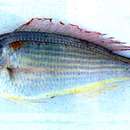Diagnostic Description
provided by Fishbase
This species is distinguished by the following characters: lower margin of eye above a line from tip of snout to upper base of pectoral fins; a line drawn up from the posterior edge of suborbital reaching the dorsal profile 2 to 4 scale rows before origin of dorsal fin; pectoral fins very long, 1-1.3 in HL, reaching to or just beyond level of origin of anal fin; pelvic fins moderately long, 1.2-1.6 in HL, reaching to or just beyond anus; caudal fin moderately forked, upper lobe slightly longer than lower and produced into a short or moderately long filament. Colour: upper part of body pinkish, becoming silvery below; top of head behind eye with a golden sheen; 11-12 pale golden-yellow stripes along body from behind head to base of caudal fin; a prominent red-suffused yellow blotch below origin of lateral line; dorsal fin whitish, margin of fin yellow, edged with red; a pale lemon stripe near base of dorsal fin, this stripe narrow anteriorly and widening on posterior part of fin; anal fin whitish with pale lemon broken lines or scribblings over most of fin; caudal fin pink, upper tip and filament yellow (Ref. 9785).
Diseases and Parasites
provided by Fishbase
Glugea nemipteri Disease. Parasitic infestations (protozoa, worms, etc.)
Diseases and Parasites
provided by Fishbase
Nosema Disease. Parasitic infestations (protozoa, worms, etc.)
Diseases and Parasites
provided by Fishbase
Helixaxine Disease. Parasitic infestations (protozoa, worms, etc.)
Life Cycle
provided by Fishbase
Females predominate at small sizes and males at larger sizes, due to faster growth rate in males (Ref. 6254).
Morphology
provided by Fishbase
Dorsal spines (total): 10; Dorsal soft rays (total): 9; Analspines: 3; Analsoft rays: 7
Trophic Strategy
provided by Fishbase
Small fish are generally most abundant in less than 27 m depth; only larger fish occur in depths greater than 45 m (Ref. 1065). Dietary preferences were crustaceans, finfishes, molluscs, polychaetes and unidentified matter (Ref. 116460).
Biology
provided by Fishbase
Very abundant in coastal waters, found on mud or sand bottoms, usually in schools. Feeds mainly on small fishes, crustaceans, mollusks (mainly cephalopods), polychaetes and echinoderms. Marketed mainly fresh, but also frozen, steamed, dried-salted, dry-smoked, fermented or made into fish balls and fish meal.
- Recorder
- Kent E. Carpenter
Importance
provided by Fishbase
fisheries: commercial
- Recorder
- Kent E. Carpenter
分布
provided by The Fish Database of Taiwan
分布於印度-西太平洋區,西起印度,北至日本琉球列島,南至印尼、菲律賓。台灣分布於西南部及澎湖海域。
利用
provided by The Fish Database of Taiwan
漁期全年皆有,可利用底拖網或延繩釣等漁法捕獲,魚肉細嫩,可用油炸、清蒸皆美味可口。
描述
provided by The Fish Database of Taiwan
體呈長紡錘形,側扁;頭端略尖,頭背呈弧形,兩眼間隔區不隆突。吻中大。眼大;眶下骨的後上角具無銳棘,下緣平滑,上緣不具前向棘。口中大,端位;上頜具4-5對犬齒,不呈水平突出;鋤骨、腭骨及舌面均不具齒。前鰓蓋後緣平滑,頰鱗
3列。第一鰓弓鰓耙數14-17。體被大櫛鱗。背鰭連續而無深刻,具硬棘
X,軟條9;臀鰭硬棘III,軟條
7;胸鰭非常長,末端達臀鰭硬棘部;腹鰭中長,達肛門;尾鰭上下葉先端呈尖形,上葉呈絲狀延長。體呈粉紅色,腹面銀白,體側有11-12條黃色縱線;側線起始處下方具一帶紅色光澤的黃斑。背鰭淡白,鰭外側黃色而具紅緣,基部具一條向後逐漸寬大的淡黃色縱帶;臀鰭淡白,具數條破碎的淡黃色縱帶;尾鰭淡粉紅色,上葉先端為黃色。
棲地
provided by The Fish Database of Taiwan
主要棲息於沿岸及近海砂泥底質的水域,棲息深度可達80公尺深。主要覓食甲殼類、頭足類或其他小魚等為食。
Nemipterus japonicus
provided by wikipedia EN
Nemipterus japonicus, commonly known as the Japanese threadfin bream, is a marine fish native to the Pacific and Indian Oceans.[1][2] The species now also occurs in the Mediterranean, having invaded as a Lessepsian migrant through the Suez Canal.[3] It is consumed by humans as an ingredient of crab sticks.[4][5][6]
References
-
^ a b Al Buwaiqi, B.; Al Abdali, F.S.H.; Al Kindi, A.S.M.; Ambuali, A.; Borsa, P.; Carpenter, K.E.; Russell, B.; Govender, A. (2019). "Nemipterus japonicus". IUCN Red List of Threatened Species. 2019: e.T46086928A46664764. doi:10.2305/IUCN.UK.2019-2.RLTS.T46086928A46664764.en. Retrieved 4 August 2021.
-
^ Froese, Rainer; Pauly, Daniel (eds.) (2021). "Nemipterus japonicus" in FishBase. June 2021 version.
-
^ Rodríguez, G.; Suárez, H. (2001). "Anthropogenic dispersal of decapod crustaceans in aquatic environments". Interciencia. 26 (7): 282–288.
-
^ Huda, N., Aminah Abdullah, and Abd Salam Babji. "Nutritional quality of surimi powder from threadfin bream." Journal of Muscle Foods 11.2 (2000): 99-109.
-
^ Musa, K. H., A. Aminah, and W. M. Wan-Aida. "Functional properties of surimi related to drying methods." Malaysian Applied Biology 34.2 (2005): 83.
-
^ Gopakumar, K., V. Muraleedharan, and S. K. Bhattacharyya. "Preparation and properties of surimi from tropical fish." Food Control 3.2 (1992): 109-112.

- license
- cc-by-sa-3.0
- copyright
- Wikipedia authors and editors
Nemipterus japonicus: Brief Summary
provided by wikipedia EN
Nemipterus japonicus, commonly known as the Japanese threadfin bream, is a marine fish native to the Pacific and Indian Oceans. The species now also occurs in the Mediterranean, having invaded as a Lessepsian migrant through the Suez Canal. It is consumed by humans as an ingredient of crab sticks.
- license
- cc-by-sa-3.0
- copyright
- Wikipedia authors and editors
Description
provided by World Register of Marine Species
Very abundant in coastal waters, found on mud or sand bottoms, usually in schools. Feeds mainly on small fishes, crustaceans, molluscs (mainly cephalopods), polychaetes and echinoderms. Marketed mainly fresh, but also frozen, steamed, dried-salted, dry-smoked, fermented or made into fish balls and fish meal.
Froese, R. & D. Pauly (Editors). (2023). FishBase. World Wide Web electronic publication. version (02/2023).
- license
- cc-by-4.0
- copyright
- WoRMS Editorial Board

